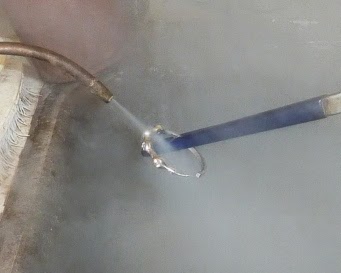Infact there is many ways of cleaning diamond jewelry, here are some methods :
Diamonds
are the hardest substance known, but that doesn't mean we can bring them back
to life with any old cleanser. Coatings and other materials used to enhance
diamonds can sometimes be removed by harsh chemicals or vigorous scrubbing, so
take care when it's time to make your diamond ring sparkle
The Three
Step Professional Jewelry Cleaning Process:
The first
step is polishing. Here the jewelry is buffed and polished on a high speed
wheel. All the little scratches and abrasions are removed and the surface of
your jewelry is restored to its original, smooth and shiny self.
Next, the
jewelry is immersed and soaked in an ultra-sonic jewelry cleaner. Together with
the cleaning solution, the ultra-sonic vibrates at a high rate, further
dislodging all the tiny particles adhering to the metal and the gemstones.
Note: Not
all gemstones can withstand the chemical cleaning solution and the vibrations
of an ultra-sonic. Diamonds, rubies, and sapphires are fine. Opals should never
be put in an ultra-sonic. If you’re unsure about a particular gemstone, check
with your jeweler.
The last
step is steam cleaning in which the jewelry is held under a powerful jet of
steam. This gets rid of any last remnant of unwanted clinging grime.
Source : Calla Gold Jewelry
Diamond is also magnets for
dirt and grime.
Whether you’re newly engaged, celebrating an anniversary or
just looking for some “bling”, you’ll want to keep that diamond jewelry
sparkling for years to come. It’s easy to clean with a few simple steps you can
do right at home.
You Will
Need:
Window/glass
cleaner with ammonia such as Windex
Mild
detergent such as Ivory
Small dish
Warm water
Small
strainer
Soft
bristled brush (a baby’s toothbrush works well)
Rubber
gloves
Lint free
cloth
The
Cleaning Process:
Close the
drain of the sink or insert a strainer into the drain. The last thing you want
is to see your precious jewelry slipping down the drain.
Fill the
sink with hot of water (as hot as you can stand). Rubber gloves will protect
your hands from the heat. Add a small
amount of mild detergent and mix.
Place the
ring in the sink or a small dish filled with this detergent-water solution and
allow it to soak for about 10 minutes. After the
ring has soaked in the water, move it to another dish filled with window
cleaner. You will want to cover the ring entirely with the cleaner. Allow the
ring to soak for an additional 10 minutes. Using the
soft brush, gently brush away dirt and build-up from the ring.
Be careful not
to scratch the metal setting with the bristles and pay careful attention to the
back of the diamond as this is a prime area for build-up that reduces the
sparkle of the diamond.
Return the
diamond to the detergent and water solution and swish around to remove any
loose dirt. Rinse
thoroughly under hot running water. Remember to keep the drain plugged or use
the strainer at all times. Allow the
jewelry to air dry or dry with a lint-free cloth.
Check the
prongs for any movement and ensure all dirt has been removed.
Additional
Tips and Advice
Toothpicks
can be used very carefully to dislodge dirt between the prongs and the diamond.
Keep
diamonds away from bleach as it damages the metal and can weaken the setting.
If you have
heavy build-up on your diamond, you may want to use a dental Water Pik to aid
in removal.
If your
diamond has a crack or “inclusion”, a sudden temperature change from placing it
in the hot water could cause the stone to break. To avoid this, warm your
diamond first in warm water.
Comments
FEBRUARY
20, 2009 AT 1:56 PM
I use
toothpaste to clean my diamond. I just put a little on a small toothbrush, and
gently scrub it all over, and under. Then, I rinse it under water and wipe it
off. This always makes it sparkle, and only takes a couple of minutes.
BARBIE
SAYS:
FEBRUARY
20, 2009 AT 7:44 PM
I tried
cleaning my 1K marquise diamond and loosened the setting so now I always take
it to my jeweler once a month due to the fact I never ever take it off except
to be cleaned. My insurance company suggested doing it that way!
MARCIA
SAYS:
FEBRUARY
27, 2009 AT 3:38 PM
NEVER clean
your jewelry with toothpaste! As a jeweler, I can tell you this is the absolute
worst!!!! Please, please, please NEVER do this.
source : cleanipedia




.jpg)



